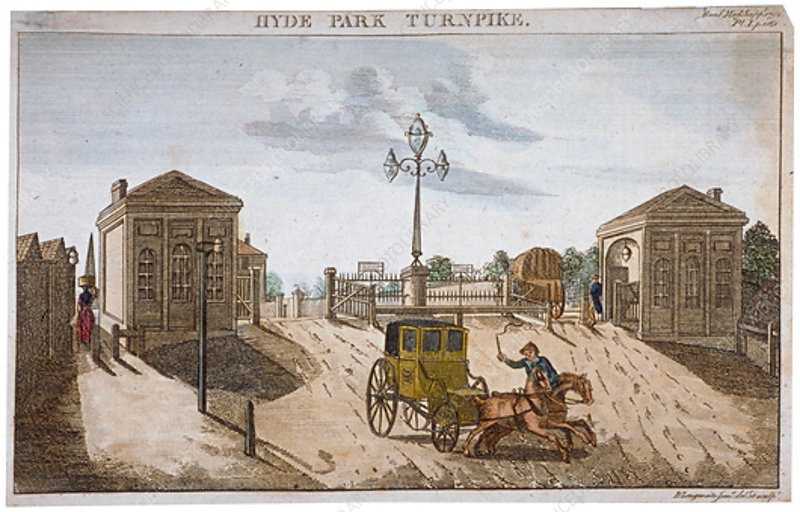 by David Zylberberg
by David Zylberberg
Last week I presented some of my research at a conference in Boston and drove from Toronto in order to do so. I have not driven in the north-eastern United States in a few years and was quickly surprised to learn that I-90 for most of its length from Buffalo to Boston has become a toll road known as the Thomas Dewey Thruway and the MassPike. The existence of tolls on a previously free road made me think about the relationship between how roads are paid for and other economic behavior.
The tolls to get from Buffalo to the Massachusetts border were $14 for my car, with a further $3.50 to get from the border to Boston. Gasoline Taxes are also lower in the United States, so at $3.39/gallon (rather than $1.18/litre in Toronto) it cost me about $15 less to fill the one tank required to get from Buffalo to Boston. In Canada, the added taxes that make gasoline more expensive contribute to the construction of roads, so are somewhat analogous to the tolls charged on some American highways and bridges. My car is fairly efficient on fuel, so while I paid about $3 more to drive on I-90 than a similar Canadian road, a larger and less-efficient vehicle would have paid less to drive on American turnpikes, despite the tolls. Which transactions are taxed affect behavior and it is worth noting that vehicles tend to be somewhat smaller in Ontario than in New York. To the extent that limiting gasoline consumption is important for limiting the problems of peak oil and climate change, New York would be well served to institute much higher gasoline taxes to replace tolls on the interstate. Such high taxes would also affect behavior on the many non-toll secondary highways and local roads. It would also be more efficient to increase gasoline taxes as they would not require building toll booths or having people collect small tolls, like the $0.15 charged when I made a brief stop in the suburbs of Buffalo.
Charging tolls in order to pay for the upkeep of roads has a long history. This was frequently done on stretches of privately maintained roads in the Roman Empire, although carts carrying grain were usually exempt. Many private roads, known as turnpikes, were built in Britain during the 18th century. These were built by private companies but required an Act of Parliament in order to expropriate land, realign fields and charge tolls. English turnpikes always had some people and goods that were exempt from paying tolls. For instance, the 1790 Act allowing for the creation of a road from Canterbury to Gutteridge Bottom exempted carts carrying manure for fields or stones to repair roads, along with people travelling to elections, soldiers, those carrying sick people or going to church. In other parts of England, carts carrying coal away from mines paid lower tolls than those carrying other goods. A number of historians have argued that the improvements in transportation with better roads, along with lower dues on coal and manure, contributed to the growth of manufacturing during the early Industrial Revolution.
The differential tolls charged to vehicles affect who pays for the upkeep of roads, as well as which vehicles are more likely to use them and the end costs of goods travelling by truck. Nobody likes traffic jams but most people would agree that the speedy passage of commercial trucks is more essential to our manufacturing economy and consumption of foods while busses allow more people to pass through the same road. An ideal combination of gasoline taxes and tolls would pay for the costs of road construction and encourage the use of more fuel-efficient vehicles while also allowing public transit and commercial trucks to move quickly. Tolls are rare in Canada, but the Ontario government, in partnership with a private company, constructed the 407 through suburban Toronto in the 1990s. There are legitimate complaints about the financial arrangements between the two parties but the current situation is a quick route for buses that connect the suburbs whose construction has been paid for with the tolls of cars willing to pay a premium for faster transit. Its off-peak tolls are $0.1935/km for light vehicles, $0.387/km for heavy single unit vehicles and $0.585/km for heavy multi-unit vehicles. New York and Massachusetts also have differential tolls depending on vehicle size but their turnpikes are dominated by transport trucks. The high tolls on transport trucks in Ontario contribute to its being mostly used by passenger cars, but if they were re-balanced it might encourage the road’s use by larger vehicles and help ease the gridlock which hampers Toronto grocery stores and manufacturing.

The I-90 was built as the New York State Thruway and was built as a toll road. It predates the Interstate System. Toll collection is simplified by using their EZ-Pass transponder which, unlike the 407, doesn’t charge me a monthly fee and offers me a discount on mileage use because I have it.
User fees, such as gasoline tax are a fair choice, if they are used as intended. But, discounting our recent stimulus construction, the last figures I saw were that the federal and provincial governments were spending less that half the gasoline tax on the highways. The rest of the money was disappearing into general revenue.